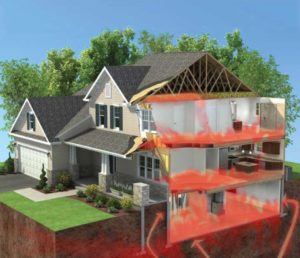Radon Mitigation involves any process designed to reduce levels of Radon in a home or building. It can be as simple as increasing ventilation or sealing cracks in the foundation. Higher initial concentrations of radon may require Active Radon mitigation.
High concentrations of Radon enter the home as the building exerts negative pressure on the soil beneath it, creating a partial vacuum which literally pulls radon-laden air inside the home.
For homers with Radon concentrations above 4.0pCi/L, the most successful and common type mitigation technique is known as Active Soil Depressurization. A fan and piping is used to draw air out from under the concrete slab(s) or from under a membrane. The withdrawal of air causes the subslab area to be a lower pressure than the air in the house. This lower or negative pressure prevents the soil gas from entering the home.
Active Soil Depressurization requires a high air flow fan designed for moderate to good air flow, can be mounted inside or outside on schedule 40 PVC vent pipe. When installing an ASD system for radon reduction, any openings, major cracks and penetrations in the building slab or membrane must be sealed.

